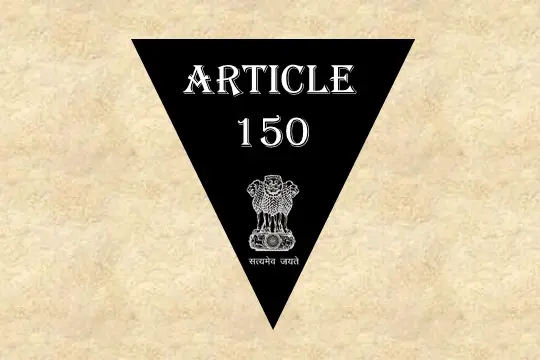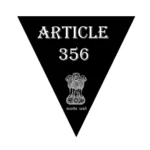यह लेख अनुच्छेद 150 (Article 150) का यथारूप संकलन है। आप इसका हिन्दी और इंग्लिश दोनों अनुवाद पढ़ सकते हैं। आप इसे अच्छी तरह से समझ सके इसीलिए इसकी व्याख्या भी नीचे दी गई है आप उसे जरूर पढ़ें।
| पाठकों से अपील 🙏 |
| Bell आइकॉन पर क्लिक करके हमारे नोटिफ़िकेशन सर्विस को Allow कर दें ताकि आपको हरेक नए लेख की सूचना आसानी से प्राप्त हो जाए। साथ ही नीचे दिए गए हमारे सोशल मीडिया हैंडल से जुड़ जाएँ और नवीनतम विचार-विमर्श का हिस्सा बनें; |

📜 अनुच्छेद 150 (Article 150) – Original
| भारत का नियंत्रक महालेखापरीक्षक |
|---|
| 1[150. संघ के और राज्यों के लेखाओं का प्ररूप — संघ के और राज्यों के लेखाओं को ऐसे प्ररूप में रखा जाएगा जो राष्ट्रपति, भारत के नियंत्रक-महालेखापरीक्षक 2[की सलाह पर] विहित करें।] ======================= 1.संविधान (बयालीसवां संशोधन) अधिनियम, 1976 की धारा 27 द्वारा (1-4-1977 से) प्रतिस्थापित। 2. संविधान (चवालीसवाँ संशोधन) अधिनियम, 1978 की धारा 22 द्वारा (20-6-1979 से) “से परामर्श के पश्चात” के स्थान पर प्रतिस्थापित। |
| Comptroller and Auditor-General of India |
|---|
| 1[150. Form of accounts of the Union and of the States.—The accounts of the Union and of the States shall be kept in such form as the President may, 2[on the advice of] the Comptroller and Auditor-General of India, prescribe.] ====================== 1. Subs. by the Constitution (Forty-second Amendment) Act, 1976, s. 27, for art.150 (w.e.f. 1-4-1977). 2. Subs. by the Constitution (Forty-fourth Amendment) Act, 1978, s. 22, for “after consultation with” (w.e.f. 20-6-1979). |
🔍 Article 150 Explanation in Hindi
अनुच्छेद 52 से लेकर 151 तक भारतीय संविधान के भाग 5 के तहत आता है। भाग 5 को 5 अध्यायों में बांटा गया है। इसी का पांचवा अध्याय है – भारत का नियंत्रक-महालेखापरीक्षक (Comptroller and Auditor-General of India)।
लोकतंत्र में जिन लोगों के पास शक्तियां और जिम्मेदारियां होती है उन्हे अपने कार्यों के प्रति जवाबदेह तो होने ही चाहिए। भारतीय संविधान इसको सुनिश्चित करने के लिए कई संस्थाओं को अधिदेशित करता है जैसे कि न्यायपालिका (Judiciary)।
इसी क्रम में एक सर्वोच्च लेखा परीक्षा संस्था (Supreme Audit Institution) SAI की भी स्थापना की गई है जिसे कि हम आमतौर पर भारत का नियंत्रक-महालेखापरीक्षक या CAG के नाम से जानते हैं। सविधान का अनुच्छेद 148 – 151 भारत के नियंत्रक एवं महालेखा परीक्षक (CAG) की विशेष भूमिका निर्धारित करती है।
संविधान का भाग 5, अध्याय V भारत का नियंत्रक महालेखापरीक्षक (Comptroller and Auditor-General of India) की बात करता है।
भारत के संविधान के अनुच्छेद 148 में नियंत्रक एवं महालेखा परीक्षक के स्वतंत्र पद की व्यवस्था की गई है, जिसे संक्षेप में ”महालेखा परीक्षक (Auditor General)” कहा जाता है। यह भारतीय लेखा परीक्षण और लेखा विभाग का मुख्य होता है।
| ⚫ अनुच्छेद 148 – भारतीय संविधान |
| अनुच्छेद 150 – संघ के और राज्यों के लेखाओं का प्ररूप (Form of accounts of the Union and of the States)
अनुच्छेद 150 कहता है कि संघ के और राज्यों के लेखाओं को ऐसे प्ररूप में रखा जाएगा जो राष्ट्रपति, भारत के नियंत्रक-महालेखापरीक्षक की सलाह पर विहित करें।
कहने का अर्थ है कि राज्य सरकार और केंद्र सरकार के सभी वित्तीय खातों को राष्ट्रपति द्वारा तय किए गए तरीके से रखना होगा। हालांकि खातों को कैसे रखा जाना चाहिए, यह तय करते समय राष्ट्रपति को भारत के नियंत्रक और महालेखा परीक्षक से परामर्श करना पड़ता है।
Overall CAG:
CAG का मतलब नियंत्रक और महालेखा परीक्षक है। यह भारत में एक महत्वपूर्ण संवैधानिक कार्यालय है जो देश के सर्वोच्च लेखापरीक्षा संस्थान के रूप में कार्य करता है। यहाँ CAG और उसकी भूमिका की व्याख्या है:
संवैधानिक स्थिति (Constitutional Position): CAG भारतीय संविधान के अनुच्छेद 148 के तहत सृजित एक संवैधानिक पद है। भारत के राष्ट्रपति CAG की नियुक्ति करते हैं, जो छह साल की अवधि के लिए या 65 वर्ष की आयु तक, जो भी पहले हो, पद पर रहते हैं। CAG कार्यपालिका और विधायिका से स्वतंत्र है।
भूमिका और कार्य (Role and Functions): CAG की प्राथमिक भूमिका विभिन्न सार्वजनिक क्षेत्र के उपक्रमों (PSUs) और स्वायत्त निकायों (autonomous bodies) सहित केंद्र और राज्य सरकारों के खातों और वित्त पर ऑडिट और रिपोर्ट करना है। CAG के ऑडिट वित्तीय प्रबंधन के सभी पहलुओं को कवर करते हैं, जिसमें राजस्व, व्यय, प्राप्तियां और सार्वजनिक धन का आवंटन शामिल है।
वित्तीय लेखापरीक्षा (Financial Audit): कैग वित्तीय विवरणों और लेन-देन की प्रामाणिकता, सटीकता और अनुपालन की जांच करने के लिए वित्तीय ऑडिट करता है। इसमें यह सुनिश्चित करना शामिल है कि वित्तीय नियमों और विनियमों का पालन किया जाता है, सार्वजनिक धन का विवेकपूर्ण ढंग से उपयोग किया जाता है, और वित्तीय अनियमितताओं या कुप्रबंधन की पहचान की जाती है।
निष्पादन लेखापरीक्षा (Performance Audit): वित्तीय लेखापरीक्षा के अतिरिक्त सीएजी निष्पादन लेखापरीक्षा भी करता है। ये ऑडिट सरकार की नीतियों, कार्यक्रमों और योजनाओं की अर्थव्यवस्था, दक्षता और प्रभावशीलता का आकलन करते हैं। इसका उद्देश्य यह मूल्यांकन करना है कि क्या सार्वजनिक संसाधनों का इष्टतम उपयोग किया जाता है और बेहतर प्रशासन के लिए सुधार की सिफारिश करना है।
रिपोर्ट प्रस्तुत करना: कैग अपनी लेखापरीक्षा रिपोर्ट संबंधित राज्य के राष्ट्रपति या राज्यपाल को प्रस्तुत करता है, जो फिर उन्हें संसद या राज्य विधानमंडल के समक्ष प्रस्तुत करता है। इन रिपोर्टों को आवश्यक दस्तावेज माना जाता है जो विधायिका को सरकारी खर्च की जांच करने और कार्यपालिका को जवाबदेह बनाने में सक्षम बनाता है।
नियंत्रक एवं महालेखा परीक्षक राष्ट्रपति को तीन लेखा परीक्षा रिपोर्ट प्रस्तुत करता है: (1) विनियोग लेखाओं पर लेखा परीक्षा रिपोर्ट (Audit report on appropriation accounts), (2) वित्त लेखाओं पर लेखा परीक्षा रिपोर्ट (Audit Report on Finance Account) और (3) सरकारी उपक्रमों पर लेखा परीक्षा रिपोर्ट (Audit Report on Government Undertakings)।
स्वतंत्रता और स्वायत्तता: CAG एक स्वतंत्र निकाय है और अपने कार्यों के निष्पादन में महत्वपूर्ण स्वायत्तता प्राप्त करता है। यह कार्यपालिका या विधायिका के नियंत्रण या प्रभाव के अधीन नहीं है। यह स्वतंत्रता सीएजी को निष्पक्ष रूप से काम करने और निष्पक्ष लेखापरीक्षा टिप्पणियों और सिफारिशों को प्रदान करने की अनुमति देती है।
| ⚫ विस्तार से समझें; अनुच्छेद 148 – भारतीय संविधान |
तो यही है अनुच्छेद 150 (Article 150), उम्मीद है आपको समझ में आया होगा। दूसरे अनुच्छेदों को समझने के लिए नीचे दिए गए लिंक का इस्तेमाल कर सकते हैं।
सवाल-जवाब के लिए टेलीग्राम जॉइन करें; टेलीग्राम पर जाकर सर्च करे – @upscandpcsofficial
Related MCQs
- The Comptroller and Auditor General (CAG) of India can be removed from office by:
a) The President of India
b) The Prime Minister of India
c) The Supreme Court of India
d) The Parliament of India
Explanation: The correct answer is (d) The Parliament of India. The Comptroller and Auditor General (CAG) of India can be removed from office only through impeachment by the Parliament. This ensures the independence of the CAG’s office and protects it from arbitrary removal.
- The Comptroller and Auditor General (CAG) submits its reports to the President or the Governor, who further submits them to:
a) The Parliament or state legislature
b) The Prime Minister or Chief Minister
c) The Finance Ministry or State Finance Department
d) The Public Accounts Committee (PAC)
Explanation: The correct answer is (a) The Parliament or state legislature. After receiving the reports from the Comptroller and Auditor General (CAG), the President or the Governor presents them to the Parliament or state legislature. This allows the legislature to examine the audit findings and take necessary actions.
- The Comptroller and Auditor General (CAG) in India is appointed for a term of:
a) 4 years
b) 6 years
c) 8 years
d) 10 years
Explanation: The correct answer is (b) 6 years. The Comptroller and Auditor General (CAG) of India is appointed for a term of six years or until the age of 65, whichever is earlier. This fixed tenure ensures independence and stability in the functioning of the office.
- The audit reports of the Comptroller and Auditor General (CAG) primarily cover:
a) Public sector enterprises only
b) Central government departments only
c) State government departments only
d) Central and state government departments, as well as public sector enterprises
Explanation: The correct answer is (d) Central and state government departments, as well as public sector enterprises. The audit reports of the Comptroller and Auditor General (CAG) cover a wide range of entities, including central and state government departments, ministries, public sector enterprises, autonomous bodies, and other organizations receiving government funds.
- The Comptroller and Auditor General (CAG) of India is considered the guardian of:
a) The Constitution of India
b) The Parliament of India
c) The Union Cabinet of India
d) The Judiciary of India
Explanation: The correct answer is (a) The Constitution of India. The Comptroller and Auditor General (CAG) of India is often referred to as the “guardian of the public purse” and the “constitutional watchdog.” The CAG’s role is to ensure financial accountability, transparency, and adherence to constitutional principles in the management of public funds.
| Related Article
| ⚫ अनुच्छेद 151- भारतीय संविधान |
| ⚫ अनुच्छेद 149 – भारतीय संविधान |
| ⚫ भारतीय संविधान ⚫ संसद की बेसिक्स ⚫ मौलिक अधिकार बेसिक्स ⚫ भारत की न्यायिक व्यवस्था ⚫ भारत की कार्यपालिका |
अनुच्छेद 150 कहता है कि संघ के और राज्यों के लेखाओं को ऐसे प्ररूप में रखा जाएगा जो राष्ट्रपति, भारत के नियंत्रक-महालेखापरीक्षक की सलाह पर विहित करें।
विस्तार से समझने के लिए लेख पढ़ें;
| अस्वीकरण – यहाँ प्रस्तुत अनुच्छेद और उसकी व्याख्या, मूल संविधान (उपलब्ध संस्करण), संविधान पर डी डी बसु की व्याख्या (मुख्य रूप से), प्रमुख पुस्तकें (एम. लक्ष्मीकान्त, सुभाष कश्यप, प्रमोद अग्रवाल इत्यादि) एनसाइक्लोपीडिया, संबंधित मूल अधिनियम और संविधान के विभिन्न ज्ञाताओं (जिनके लेख समाचार पत्रों, पत्रिकाओं एवं इंटरनेट पर ऑडियो-विजुअल्स के रूप में उपलब्ध है) पर आधारित है। हमने बस इसे रोचक और आसानी से समझने योग्य बनाने का प्रयास किया है। |














